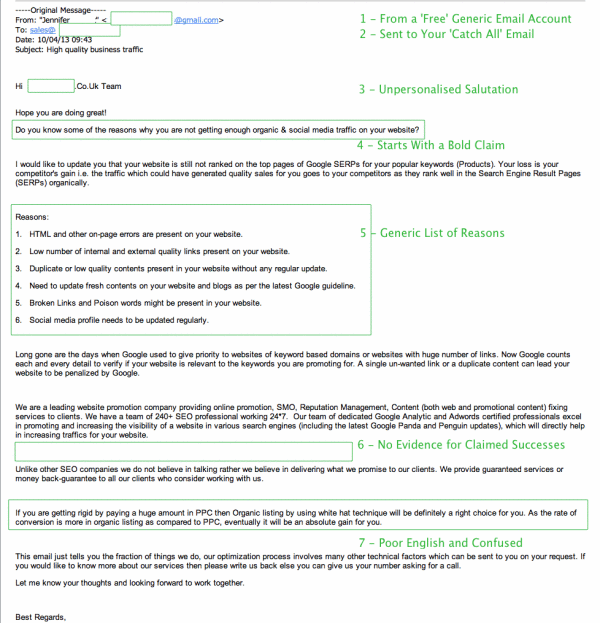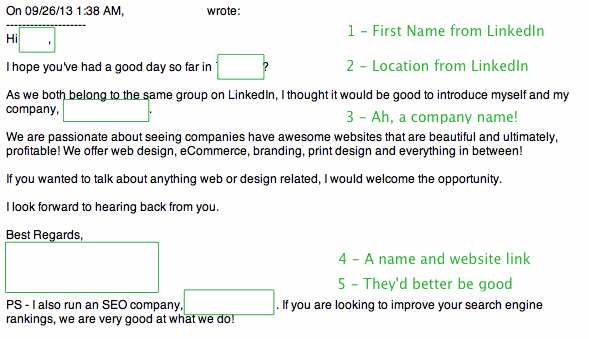We get about three of these emails a day, they drop into our inbox and we normally delete them. It’s easy to read the ‘tells’ that give away they’re spam. However we were surprised that clients still forward to these for our comments, so thought it best to help by showing you what we do to evaluate this kind of contact.
Here’s a typical email and how we deconstruct it:

1. Sent From a ‘Free’ Generic Email Account
Let’s start with the obvious: it’s sent from a gmail account. Anyone can get a Gmail account (or Yahoo! or Hotmail for that matter). They are free, but also they don’t tell you anything about the sender, so immediately we are on ‘amber’ alert.
2. Sent to Your ‘Catch All’ Email Account
This one was sent to info@[clientsdomainname], some try, admin@ or sales@… it doesn’t really matter, but if the email is not sent to a named email address and you’ve never heard from them before, the chances are they don’t know anything about you or your business.
3. Impersonal Greeting / Salutation
If they’re going to start telling you things about your website and get all personal, it would be nice for them to approach you by name – it would show they know (or, in this case, don’t know) who they’re talking to.
4. Kicking Off With a Bold Claim
The easiest way to get attention is to poke someone in the ribs. Therefore the first item on the list is to tell them something that they would like to improve – rankings, visibility, traffic, sales. Everyone, even the successful, could be doing better, so this is an easy ‘win’.
5. Give Them the Reasons
However out of date, however unsubstantiated, these emails are normally filled with seemingly impressive reasons and claims for findings.
6. No Evidence of Success or Skills
At the same time, the emails fail to give any evidence of the claims made, because they almost certainly have not visited the website in question and prefer not to even identify themselves.
7. Poor English
Most of these emails emanate from outside of the UK, commonly Asia or Eastern Europe, they often reveal the hurried and chaotic approach of the sender and give you a clue as to what kind of service to expect.
What Action Should You Take?
The next time one of these emails drops into your inbox, use these checks. If the email sent to you contains most or all of these tells just ignore and delete. Whatever you do, do not reply, or you will waste further valuable hours of your life!
LinkedIn Spam – The Approach is Closer to Home
And, here’s a new one received the other week through LinkedIn, sadly it was from an agency based in the South of England. We can apply the same logic and checks to see if we can pick out the tells in this one.

Firstly because it’s through LinkedIn there’s no credit to the sender for getting a name and location from a LinkedIn profile. The clumsy use of the location in my salutation actually put me off, because it’s not actually where I work, just the nearest town. I suppose it demonstrates a modicum of effort on the part of the sender, but after that it goes rapidly downhill.
The thing is here we can see two things:
- That the sender is pitching for new business but offering no real evidence in the email of even realising he’s sent this (probably accidentally), to another marketing agency
- He’s very kindly given two business names so we can take a look at his website and judge for ourselves
If They Tell You Who They Are, then DDD: Do Due Diligence
So, how can we tackle this? The best way is to judge the various claims he’s made in the email.
- ‘Awesome websites’: OK, let’s have a look, his site is OK (I mean really on the moderate side of OK), the client sites listed, really un-awesome.
- ‘Design, eCommerce, branding, print design and everything in between’: again, sounds great, must have a whole army behind him and been in the business years. Er, no, checking his LinkedIn profile shows that this outstanding digital agency has been going less than a year – and previous jobs hardly spark excitement or give evidence to this broad range of skills.
- ‘SEO company’: ah, so, in less than a year all of these amazing things aren’t enough, he’s also got a SEO company. So let’s see how well optimised his current website is. He can’t even get onto page one of Google for ‘web design in [TinyTown]’ (the town his business is based in). So, if he can’t even optimise his own, what chance would a client have?
We hope this demonstrates, either way, that you can easily discover for yourself whether one of these emails is worth taking the time on. If you start from the basis of ‘probably spam but prove me wrong’ then we’re confident you’ll come up with the right answer in your investigations.
What Action Should You Take?
That’s up to you, I think this kind of approach makes a mockery of what LinkedIn should be – proper value-added networking opportunities, not unsolicited lazy spam.
So I replied to the sender and marked it as Spam in LinkedIn. And, if you’re reading this in the forum he went through in the first place, we can share the joke too.
Happy hunting!

